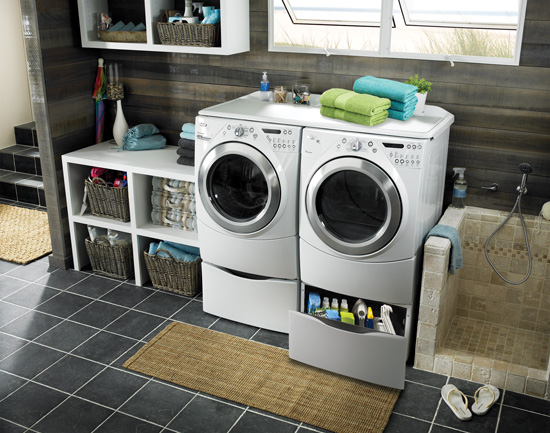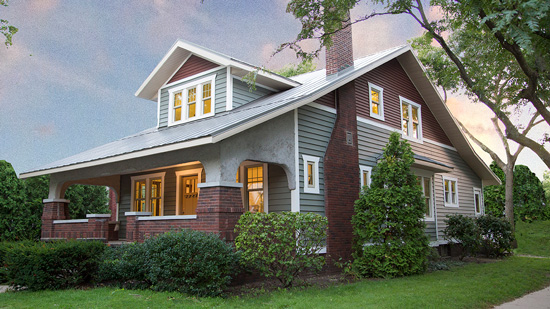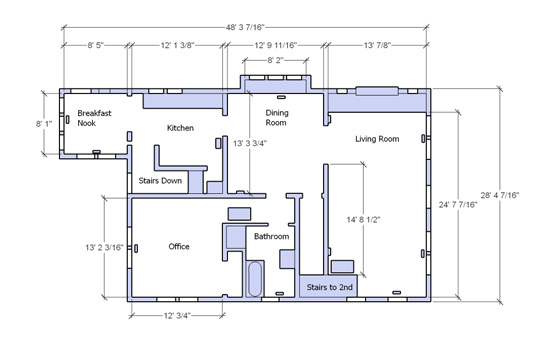The Intersection of Universal Design and Sustainable Living
Coordinated Laundry Design
Laundry equipment can be located in a laundry room that can accommodate multiple functions or be integrated into clothes hanging or dressing areas. In either case, the first choice in laundry appliances is whether to use front-loading or top-loading appliances. Those appliances that operate by spinning on a horizontal axis (hence the front loading) are generally much more efficient than conventional vertical-axis (top-loading) models. In washing machines, this is attributed in large part to the fact that top-loading machines with agitators need to fill the tub completely with water, while the horizontal axis machines do not. Hot water heating accounts for about 90 percent of the energy consumed by a clothes washer—only about 10 percent goes to the electricity to run the washer motor. Hence, specifications for washers should clearly address both energy and hot-water usage. If water efficiency is a particular concern, note that washers are rated with a Water Factor (WF) that indicates the number of gallons needed for each cubic foot of laundry. The lower the WF, the less water needed to operate.

Photo Courtesy of Whirlpool Corporation
Front-loading washers and dryers offer better energy efficiency and easier accessibility, with the option of storing detergents and laundry products more conveniently.
When it comes to clothes dryers, the fundamental choice is between electric and gas-fired models. In terms of comparative energy use, gas dryers are generally less expensive to operate. However, most sources agree that there is not a lot of variation in overall energy actually used between models. Typically, it is usage and running time that dictate the amount of energy used. Therefore, controls for turning off dryers become the major consideration for energy consumption, particularly if coupled with an efficient washer that has extracted a lot of the water out of the clothes already. The fundamental controls choice is whether or not the dryer uses sensors to automatically turn off the dryer once clothes are dry. The alternative is timed drying, leaving the running time, and corresponding energy use, to the guesswork of the user. The best dryers have moisture sensors inside the drum for sensing dryness and turning off the machine. Most others only infer dryness by using temperature sensors in the exhaust air portion of the dryer, which may result in running the dryer longer than needed. Compared with timed drying, savings of about 10 percent with temperature-sensing controls and 15 percent with moisture-sensing controls are possible.
The main universal design concerns in the laundry have to do with front loading access and easily accessed front controls, both of which make the appliances easier to use. Originally, these appliances were placed side by side on platforms, raising them so people using wheelchairs could open the doors on front loaders above their knees. Like so many things, standing users found that they could benefit from this arrangement by not needing to bend over to access the appliances. Some manufacturers provide a drawer in the platform to hold dispensers of detergent so lifting heavy laundry detergent bottles is simplified. It’s also worth noting that the laundry room has become a much more important space in the home often expanding in size to accomplish many other tasks such as folding, ironing, mending, storage, and other things. The universal design implication here is that the whole room has to be accessible and usable by all.
Conclusion
Universal design and sustainability are important and closely related design aspects of many buildings, particularly residential ones. This is evidenced throughout the building but quite strikingly in the design of kitchen and laundry areas. The variety of standards and resources available allow design professionals to confidently create integrated design solutions that can respond to the differences in the people who will use them, to differences that can occur in any one person’s life, or in differences over the life of the building. Allowing for this efficiency and flexibility allows buildings to last longer and be truly more sustainable.
 |
Whirlpool Corporation, the leading manufacturer of major home appliances, brings you Inside Advantage®—innovative products providing efficiency and performance; market insights helping you to create more appealing designs; and targeted services that make doing business with them easier and more profitable. www.insideadvantage.com |










